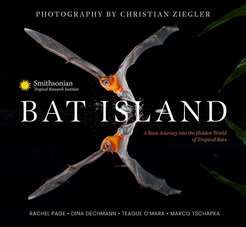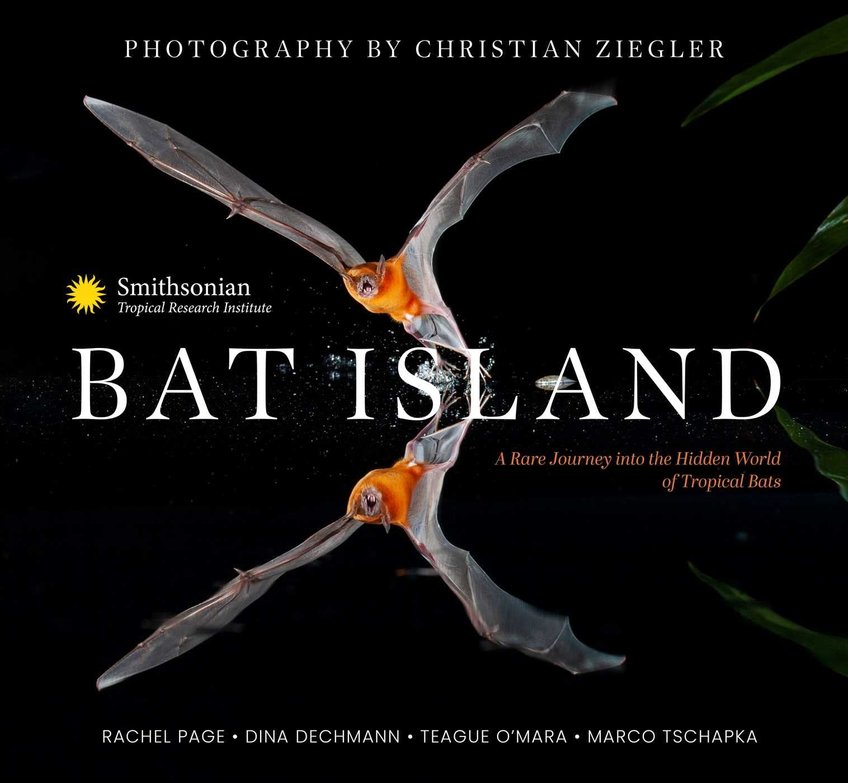Bat Island
New book charts a rare journey into the hidden world of tropical bats

In his career as a wildlife photographer travelling on assignment for glossy magazines, Christian Ziegler has witnessed more risk, reward, and rare beauty than can be easily imagined. Yet few experiences stand out like a night, 25 years ago, spent dangling over a giant fig tree in the company of a bat researcher named Elisabeth Kalko.
At the time Ziegler was an ecology student turned amateur photographer who had taken an interest in documenting Kalko’s research on bats in Barro Colorado Island (BCI), a research station of the Smithsonian Tropical Research Institute (STRI) in Panama.
That particular night, the pair had set out into the dark rainforest to witness the five-day fruiting period of an enormous fig tree; and the “insane” feeding frenzy that ensued. “Every fruit-eating animal in the forest—monkeys, birds, bats, you name it—they were all at this tree,” says Ziegler, who is a staff photographer for the Max Planck Institute of Animal Behavior. And so it was that the photographer found himself perilously far from the ground, in a crane hired especially for the event, in the cyclonic center of a neotropical bat swarm. “It was gloriously loud,” remembers Ziegler of his privileged position at this natural spectacle, “and it was all thanks to Eli’s pioneering work that we could be there at all.”
This marked the beginning of a mission, spanning a quarter of a century, to photograph the astonishing diversity of bats at BCI, which number over 70 species. Ziegler’s mission was animated by the deep biological insights gained by Kalko, and other STRI bat scientists, that have resulted in the most comprehensive and long-term datasets on tropical bats anywhere in the world. Today, this effort has culminated in a hardcover book—Bat Island—published by Insight Editions.
Bat Island showcases 150 of Ziegler’s photographs that make visible the extraordinary environmental adaptations and rich natural history of BCI’s bats. Behaviors such as pollinating, fishing, and roosting are captured in incredible detail and color. The images, in turn, are contextualized in 14 chapters written by bat scientists long affiliated with STRI: Dina Dechmann from the MPI-AB, as well as Rachel Page, Teague O’Mara and Marco Tschapka. The authors bring their expertise to bear on synthesizing the intensive study of STRI bat researchers on topics such as bats’ diverse sensory abilities, foraging strategies, roosting ecologies, and social systems.
Bat Island is on sale from today.
On the day of release, Christian Ziegler and Dina Dechmann reflect on Bat Island’s making, and hopes for its legacy.
Bat Island is dedicated to Elisabeth Kalko. What was Elisabeth’s role in making this book?
Dina Dechmann: Eli was one of the people who really made a difference for bat research on BCI. Although people had been working on bats there almost since the formation of the island, she started bringing a lot of students there and tackling the question of how the great species diversity can coexist. She, with others, came up with the “guild concept” and started comparing species. Christian and Eli were going to write a book and he took the pictures while she wrote an outline. But Eli unexpectedly passed away at the ago of 49 and the book came to a standstill. Rachel, Teague, Marco and I wrote the book in her memory and also to make sure Christian's pictures could be finally shared with the world.
What were the technical hurdles of photographing nocturnal flying animals?
Christian Ziegler: When I began capturing photos of bats, I was navigating a steep learning curve. Night time photography is its own challenge, but back in the 90s I was still working with slides. This meant that it took two weeks for me to see the photo and realise that it was a total failure. And I had loads of failures. When I finally transitioned to digital photography around 2005 things really improved. I could instantly review my shots, particularly the use of flashes that I could adjust in the moment. Eventually I developed a system of up to 8 flashes to illuminate the bats' actions and to capture light and detail. I love all the photos, but I’m probably most proud of the series capturing a bat fishing over a lake. To make those photos, I had two boats with 500 Watt lights illuminating the background while I stood on a dock facing the water. I used four flashes set on strobe to expose the bat as it flew over the water. Out of thousands of photos, I captured ten that worked.
Looking back on the bat research at BCI, what are the highlights?
Dina Dechmann: People have always researched bats on BCI, but since Eli first came to BCI (which was also more than 20 years ago) we really have learned a lot about niche differentiation. How can so many species coexist and what are the adaptations in morphology, behaviour, echolocation etc that came with that? Echolocation was Eli's great strength and she was crucial in developing the first technologies that allowed us to study it in the field. We have also learned a lot about bat interactions with their food (insects, nectar-producing flowers, fruit). We also know a lot more about their social systems and how they are influenced by the food bats feed on/are restricted to. People like Rachel have worked a lot on sensory perception, behavioural flexibility and social learning. The diversity of people studying bats and their scientific interests are becoming broader and broader. Currently there is someone comparing bats with other species including humans to understand similarities in language.
What do you hope will come about from publishing Bat Island?
Christian Ziegler: Bat Island is different for being a bat book written for people who don’t already know a lot about bats. It’s not a book for scientists. I hope this book changes peoples’ minds about a very misunderstood group of animals. Bats are unique among mammals: they have acquired true flight, provide essential ecosystem services, and represent the ecologically most diverse group of mammals worldwide. Yet they are often maligned, especially in their role as agents of disease. I hope people see that bats need our help. They are threatened by habit fragmentation and land degradation. We desperately need to enact initiatives to ensure the survival of these animals which are critical to maintaining healthy, balanced ecosystems.












